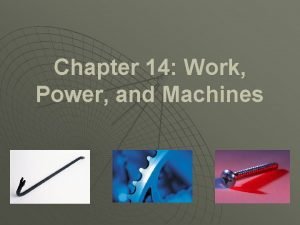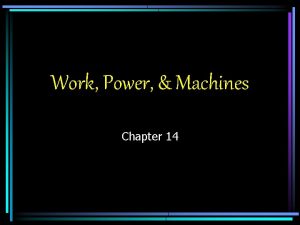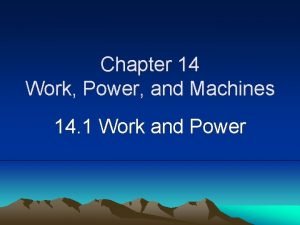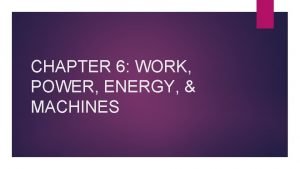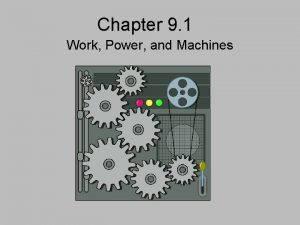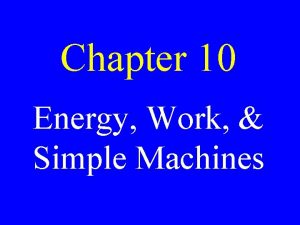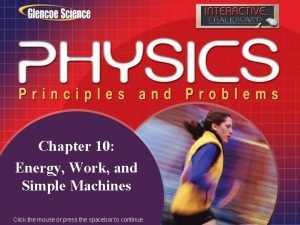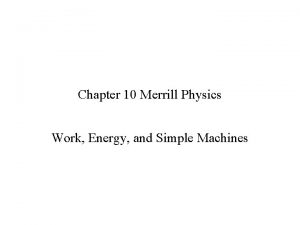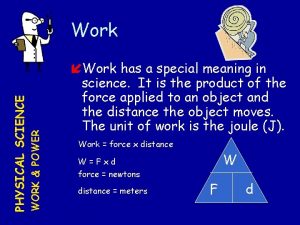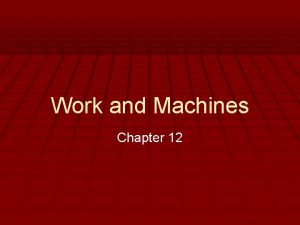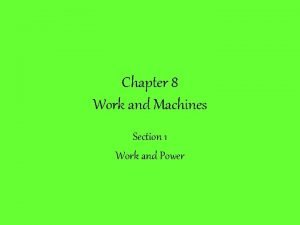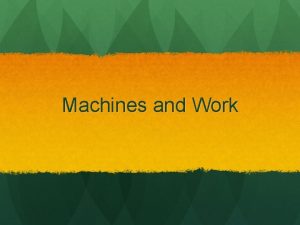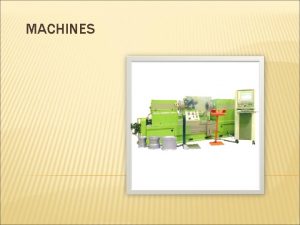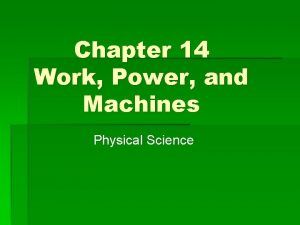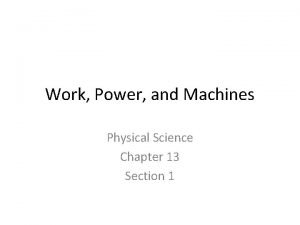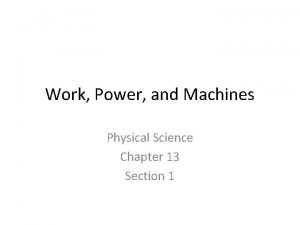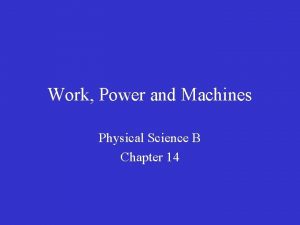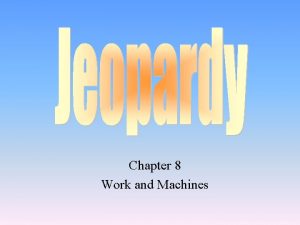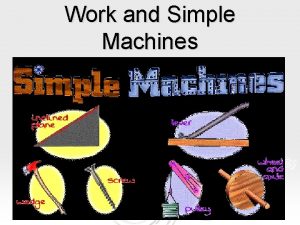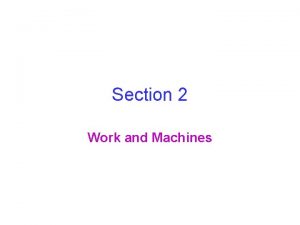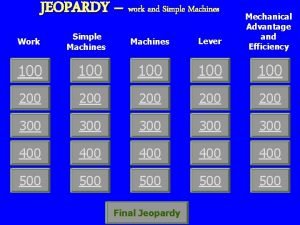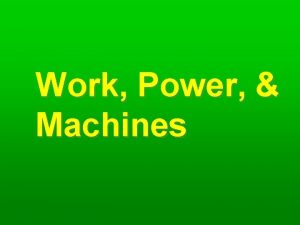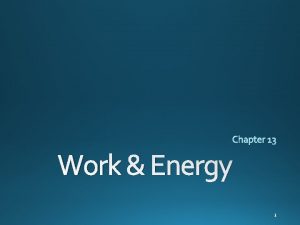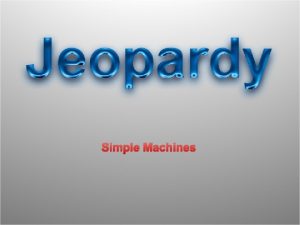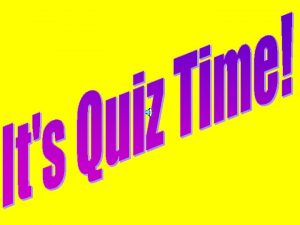Chapter 14 Work Power and Machines Physical Science
















- Slides: 16

Chapter 14 Work, Power, and Machines Physical Science

Work and Power 14. 1 § Work – done when a force acts on an object in the direction the object moves § Requires Motion § Man is not actually doing work when holding barbell above his head § Force is applied to barbell § If no movement, no work done He does work They do no work

Work and Power 14. 1 Work Depends on Direction § All force acts in same direction of motion = all force work. § Part applied force acts in the direction of motion =part force does work. § none of force in direction of the motion = force does no work.

Work and Power 14. 1 Work Depends on Direction Continued… • • • All of the force does work on the suitcase. The horizontal part of the force does work. The force does no work on the suitcase. Force Direction of motion Force and motion in the same direction This force does work This force does no work Direction of motion Part of force in direction of motion Force Direction of motion Lifting force not in direction of motion

Calculating Work 14. 1 § Work = Force x Distance § W = Fd § Force = mass x acceleration F = ma or F = mg § Joule (J) = SI unit for work § Unit: J = N(m) § Named after James Prescott Joule (1818 – 1889) § Research work and heat Example: If a model Work = Fd airplane exerts 0. 25 N =. 25(10) over a distance of 10 m, = 2. 5 J the plane will expend 2. 5 J.

What is Power? 14. 1 § Rate of doing work § More power = work at a faster rate § Size of engine often indicates power § Can work at a faster rate § Power = Work/Time § P= W/t § Watt (W) = SI unit for Power § Units: W = J/s

What is Power? 14. 1 Because the snow blower can remove more snow in less time, it requires more power than hand shoveling does.

Math Practice – Page 415 # 1 - 3

James Watt and Horsepower 14. 1 § Horsepower (hp) = another unit for power § Equals ~746 watts § Defined by James Watt (1736 - 1819) § Trying to describe power outputs of steam engines § Horses were most common used source of power in 1700 s

James Watt and Horsepower The horse-drawn plow and the gasoline-powered engine are both capable of doing work at a rate of four horsepower.

Assessment Questions 1. In which of the following cases is work being done on an object? a. pushing against a locked door b. suspending a heavy weight with a strong chain c. pulling a trailer up a hill d. carrying a box down a corridor 2. A tractor exerts a force of 20, 000 newtons to move a trailer 8 meters. How much work was done on the trailer? a. 2, 500 J a. 4, 000 J b. 20, 000 J c. 160, 000 J 3. A car exerts a force of 500 newtons to pull a boat 100 meters in 10 seconds. How much power does the car use? a. 5000 W b. 6000 W c. 50 W d. 1000 W

Work and Machines 14. 2

Machines Do Work 14. 2 § Machine – device that change force § Car jack § You apply force jack changes force applies much stronger force to lift car § Jack increase force you exerted § Make work easier § Change size of force needed, direction of force, and distance over which force acts

Machines Do Work 14. 2 § Increasing Force § Small force exerted over a large distance = large force over short distance § Like picking books up one at a time to move them --trade off = more distance but less force

Machines Do Work 14. 2 § Increasing Distance § Decreases distance force exerted and increases amount of force required § Tradeoff = increased distance = greater force exerted § Changing Direction Boat moves in this direction. Input force Input distance Output force Output distance

Work Input and Work Output 14. 2 § Work input to a Machine § Input Force – Force you exert on a machine § Oar = force exerted on handle § Input Distance – Distance the input force act thru § How far handle moves § Work Input – work done by the input force § Fxd § Work Output of a Machine § § § Output Force- force exerted by machine Output Distance – distance moved Work output – F x d § Less than input work b/c of friction § All machines use some input work to overcome
 Chapter 4 work and energy section 1 work and machines
Chapter 4 work and energy section 1 work and machines Chapter 14 work power and machines
Chapter 14 work power and machines Chapter 14 work power and machines
Chapter 14 work power and machines Chapter 14 work power and machines
Chapter 14 work power and machines Work power energy and machines
Work power energy and machines Work power and machines
Work power and machines Energy work and simple machines chapter 10 answers
Energy work and simple machines chapter 10 answers Chapter 10 energy, work and simple machines answer key
Chapter 10 energy, work and simple machines answer key Energy work and simple machines chapter 10 answers
Energy work and simple machines chapter 10 answers Chapter 10 energy work and simple machines answer key
Chapter 10 energy work and simple machines answer key Power physical science
Power physical science Power triangle
Power triangle Branches of biology
Branches of biology Natural science vs physical science
Natural science vs physical science The force you exert on a machine
The force you exert on a machine Section 1 work and machines
Section 1 work and machines Section 2 describing energy (continued)
Section 2 describing energy (continued)

